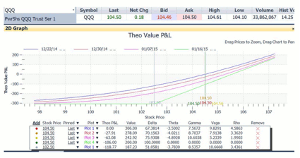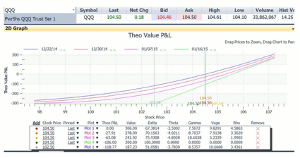Today, options instructor Russ Allen,of Online Trading Academy, highlights the ins and outs of intrinsic and extrinsic value in relation to options and points out the three main things that affect the amount of time value in a specific option.
The title of this article is somewhat tongue-in-cheek but the issue it describes is real. What I’m talking about is the amount of time value in an option and the things that change the rate at which that time value declines.
A couple of definitions are in order. First, the value of an option is called its premium. This is the price at which the option can be bought or sold.
The two possible components of an option’s premium are its intrinsic value and its extrinsic value (also called time value). Note that I said the two possible components. Some options have only intrinsic value, some have only time value, some have both, and some have neither and therefore have no value at all.
An option’s intrinsic value is the amount of positive cash flow, if any, that could currently be realized by exercising the option and then liquidating the resulting stock position.
The option’s extrinsic value (or time value) is the excess, if any, of the option’s total value above its intrinsic value.
For example: Stock QQQ is at $104.50. A call option with a $102.50 strike price and 25 days until expiration is selling for $3.06. If we owned such an option and exercised it last Tuesday, we would acquire QQQ stock at the $102.50 strike price. That’s the right that the $102.50 call gives us. If we then liquidate the QQQ stock at its current market value of $104.50, we would have positive cash flow equal to the $104.50 stock proceeds, less the $102.50 that we just paid for the stock or $2.00. That $2.00 is the option’s intrinsic value.
So, a quick way of calculating intrinsic value for a call option is stock price minus strike price. In this case, that is $104.50-$102.50 or $2.00. By the way, if the stock price were below the strike price, then this calculation would give a negative number. In that case, the negative number is disregarded and the option’s intrinsic value is said to be zero.
With the total value of the call option at $3.06, we can calculate its time value by subtracting its $2.00 intrinsic value. This gives a time value amount of $3.06-$2.00 = $1.06.
Now for the relativity part.
Why is that option’s time value $1.06 and not some other number?
The three main things that affect the amount of time value in a specific option are these:
- How far the stock price is from the strike price. The closer it is, the greater the time value.
- How much time remains until the option expires. The more time, the more time value.
- How fast the stock is expected to move. Greater expected movement means greater time value.
In our example, our $102.50-strike call now has $1.06 of time value out of a total value of $3.06. Below is a chart showing what this option’s value would look like at selected future dates:

Factors for original option pricing models
Click to Enlarge
In this chart, the three curved lines represent the amount of profit or loss that this option would show at different QQQ stock prices. The blue line is as of last Tuesday; the red line is as of eight days in the future; the magenta line is as of 16 days out; and the green line is as of the expiration of January 16, 18 days away.
NEXT PAGE: Further Analysis of the Chart
|pagebreak|
Factors for original option pricing models
Click to Enlarge

Factors for original option pricing models
Click to Enlarge
Note the table under the chart, and in particular, the Value column. The first four rows in the table give the value of this $102.50 call option if QQQ’s price is unchanged at $104.50 on the four dates mentioned above. Note that the value declines relentlessly from $306 last Tuesday, through $278, $243, and, finally, to $200 as of January 16.
On that fourth row, we can see that if QQQ remains unchanged at $104.50 until January 16, the remaining value of the $102.50 call will be exactly $200 ($2.00 per share), which is its intrinsic value. This means that it will have zero time value. It will have lost all its time value to time decay, with no change in the price of the stock.
Now notice the fifth row of the table. This has a different stock price, which is $102.50, the same as the call strike price. It is displaying the values as of last Tuesday (the blue curve) should QQQ drop by $2.00, down to $102.50.
The Value column in the table for this last row shows $187.23. This means that if QQQ were to drop to $102.50 Monday, the value of the option would drop from $3.06 to $1.87 per share, a loss of $1.19 per share. But note that at a QQQ price of $102.50, the $102.50 call option would have no intrinsic value. Stock price-strike price would be $102.50-$102.50 = $0.00.
With no intrinsic value, the entire value of $1.87 would have to be time value. That is actually $.81 more than the $1.06 of time value the option had with QQQ at $104.50. So, after a $2.00 drop in the stock, the option will have dropped from $3.06 to $1.87, a drop of $1.19. But this $1.19 drop will be the net of a decrease of $2.00 in intrinsic value and an increase of $.81 in time value.
This illustrates that an option whose strike price is closer to the stock price has more time value than one whose strike price is farther away from the stock price.
We can now turn this around the other way. If the $2.00 drop in QQQ happened last Tuesday, then we would expect the $102.50 strike calls to be selling for $1.87, as described above. But let’s say that after dipping down, the stock recovers on the same day right back to $104.50. We would expect the value of the option to go right back to $3.06. Now, the trip back from $1.87 to $3.06 will have involved an increase of $2.00 in intrinsic value and a drop of $.81 in time value. From the $1.87 bottom, the option will have gained $1.19 in total while actually losing time value. If QQQ then continues to rise, the $102.50 call will continue to gain value. But this will be by increasing its intrinsic value while simultaneously losing time value. At a price that is so high that there is no realistic possibility of QQQ dropping back to $102.50 before option expiration, the $102.50 calls will have lost all of their time value. At that point, the options will trade at exactly their intrinsic value. Since their intrinsic value, being stock price minus strike price, always changes penny for penny with the stock price, the option premium will now do the same.
In summary, here are the points that you should take away from this article:
Time value in an option is elastic based on stock price movement. It can increase even when the option price itself drops or vice versa.
Time value declines over time, but can reach zero long before expiration if the stock price moves far enough.
Once the time value is gone there is no point in continuing to hold a short option position as there is no chance of its improving with time.
By Russ Allen, Instructor, Online Trading Academy





















